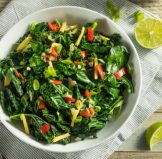
Though commonly associated with culinary traditions of the Southeastern US, collards originated in Europe, along with kale, cabbage etc., and are easy to grow in cooler climates, too.
Grow collards in full sun (for fastest growth), or part shade. Give them plenty of space, 18” apart. Collards appreciate moist, fertile soil with plenty of organic matter (compost) and applications of compost tea.

Collards ‘Vates’ Seedsavers Exchange
In our climate, collards can be seeded directly in the garden two weeks before the average last frost date (May 9 for us), or seeds can be started indoors four to six weeks prior to the last frost date.
Collard greens can be grown in succession for a constant supply of young, tender salad greens during the hot months when arugula, spinach and lettuce are finished.
Harvesting and Eating Collard Greens

Green Collard Greens with Pepper and Ginger
Leaves can be harvested individually, from the bottom up before they reach 12” long (while still tender) or whole plants can be harvested. In the Southeast, they are mostly grown for harvesting in fall and winter and are traditionally cooked long and slow with seasonings and cuts of pork or ham.
But fresh, tender collard leaves can be finely chopped after ribs have been removed, and briefly sauteed in extra virgin olive oil with minced garlic, salt, and pepper. Collards can also be fermented to make Cabbage Collard Kraut.
Harlequin’s Gardens offers starts of Vates, Georgia Southern and Cascade Glaze varieties, and seeds for Vates and Georgia Southern collard greens.
